A Novel Fuel-Based CO2 Transcritical Cycle for Combined Cooling and Power Generation on Hypersonic Aircrafts
Abstract
:1. Introduction
2. Thermodynamic Analysis on FCTCP System
2.1. Working Principle
2.2. Thermodynamic Model
2.2.1. Model Establishment
- (1)
- The energy exchange between the overall cycle and the external environment is negligible.
- (2)
- The pressure loss in the pipelines and connections is negligible.
- (3)
- The fuel consists solely of n-decane, and its thermal properties of the fuel in the wall cooling channels are unrelated to the thermal cracking reaction [7].
2.2.2. Evaluation Metrics
3. Establishment and Validation of the Steady-State Simulation Model
3.1. Steady-State Simulation Model
3.1.1. Scroll Expander Model
3.1.2. Working Medium Pump Model
3.1.3. Heat Exchanger Model
3.2. Model Validation
3.2.1. Validation of the Expander Model
3.2.2. Validation of the Heat Exchanger Model
4. Results and Discussion
4.1. Thermodynamic Analysis
4.1.1. Impacts of a Fuel Flow Rate on the Circulating Cooling Process
4.1.2. Impacts of a Wall Cooling Channel Outlet Temperature on Performance
4.1.3. Impacts of an Endothermic Pressure on Performance
4.1.4. Impacts of Fuel Temperature on Performance
4.2. Performance Analysis under Steady States
4.2.1. Impacts of Combustion Chamber Wall Temperature on Steady-State Performance
- (1)
- The fuel composition is n-decane.
- (2)
- The thermal properties of the fuel and the thermal cracking reactions in the wall-cooled channels are unrelated.
- (3)
- There is no pressure loss in the working fluid flow within the heat exchanger.
4.2.2. Impacts of Fuel Flow on Steady-State Performance
5. Conclusions
Author Contributions
Funding
Data Availability Statement
Conflicts of Interest
Abbreviations
| Nomenclature | |
| FCTCP | fuel-based CO2 transcritical cooling and power system |
| FVT | Fuel Vapor Turbine |
| PCHE | printed circuit heat exchanger |
| S-CO2 | supercritical CO2 |
| ORC | organic Rankine cycle |
| Subscript | |
| cond | condenser |
| cool | cooler |
| cri | critical state |
| d | design parameter |
| e | expansion process of expansion chamber |
| ex | expander outlet section |
| f | fuel |
| loss | loss |
| p | working fluid pump |
| pre | preheater |
| re | regenerator |
| su | expander inlet section |
| wall | combustion chamber wall |
| cold | cold fluid |
| hot | hot fluid |
References
- Becker, J. New Approaches to Hypersonic Aircraft; NASA Langley Research Center: Hampton, VA, USA, 1970. [Google Scholar]
- Feng, Y.; Qin, J.; Bao, W.; Yang, Q.; Huang, H.; Wang, Z. Numerical analysis of convective heat transfer characteristics of supercritical hydrocarbon fuel in cooling panel with local flow blockage structure. J. Supercrit. Fluids 2014, 88, 8–16. [Google Scholar] [CrossRef]
- Zhang, S.; Feng, Y.; Zhang, D.; Jiang, Y.; Qin, J.; Bao, W. Parametric numerical analysis of supercritical cooling in hydrogen-fueled scramjet engines. Int. J. Hydrog. Energy 2016, 41, 10942–10960. [Google Scholar] [CrossRef]
- Segal, C. The Scramjet Engine: Processes and Characteristics; Cambridge University Press: Cambridge, UK, 2009. [Google Scholar]
- Li, H.W.; Liu, Y.C.; Gan, J.Z. A Comprehensive Review of research on combined cooling and power supply technology for hypersonic vehicles. Guid. Missile 2021, 12, 63–68. (In Chinese) [Google Scholar] [CrossRef]
- Cheng, K.L. Performance Study of Combined Power Generation System for Hypersonic Aircraft Based on Cold Source Cascade Utilization. Ph.D. Thesis, Harbin Institute of Technology, Harbin, China, 2020. (In Chinese). [Google Scholar] [CrossRef]
- Zhang, D.; Bao, W.; Qin, J. Performance Assessment of Oil-Gas Turbine for Hydrocarbon-fueled Supersonic Combustion Ramjet Engine. Propuls. Technol. 2013, 34, 1708–1712. (In Chinese) [Google Scholar] [CrossRef]
- Ma, Z.; Zhang, X.J.; Yang, C.X. Brayton Thermoelectric Conversion Technology for Thermal Protection of Hypersonic Aircraft. Tactical Missile Technol. 2014, 4, 20–25. (In Chinese) [Google Scholar] [CrossRef]
- Bao, W.; Qin, J.; Yu, D.R. Reheat Closed Brayton Cooling Cycle System for Supersonic Combustion Ramjet Engines. CN101576024B, 5 January.
- Jiang, P.X.; Zhang, F.Z.; Xu, R.N. Integrated System for Thermal Protection and Power Generation of Hypersonic Aircraft Engine. J. Aeroengine 2021, 36, 1–7. (In Chinese) [Google Scholar] [CrossRef]
- Hou, S.Y.; Yang, Q.G. Multi-objective optimization of supercritical CO2-organic Rankine combined cycle. J. Power Eng. 2024, 44, 658–664. (In Chinese) [Google Scholar] [CrossRef]
- Ahn, Y.; Bae, S.J.; Kim, M.; Cho, S.K.; Baik, S.; Lee, J.I.; Cha, J.E. Review of supercritical CO2 power cycle technology and current status of research and development. Nucl. Eng. Technol. 2015, 47, 647–661. [Google Scholar] [CrossRef]
- White, M.T.; Bianchi, G.; Chai, L.; Tassou, S.A.; Sayma, A.I. Review of supercritical CO2 technologies and systems for power generation. Appl. Therm. Eng. 2021, 185, 116447. [Google Scholar] [CrossRef]
- Habibollahzade, A.; Petersen, K.; Aliahmadi, M.; Fakhari, I.; Brinkerhoff, J. Comparative thermoeconomic analysis of geothermal energy recovery via super/transcritical CO2 and subcritical organic Rankine cycles. Energy Convers. Manag. 2022, 251, 115008. [Google Scholar] [CrossRef]
- Guo, Y.; Guo, X.; Wang, J.; Li, Z.; Cheng, S.; Wang, S. Comprehensive analysis and optimization for a novel combined heating and power system based on self-condensing transcritical CO2 Rankine cycle driven by geothermal energy from thermodynamic, exergoeconomic, and exergoenvironmental aspects. Energy 2024, 300, 131581. [Google Scholar] [CrossRef]
- Song, J.; Li, X.; Ren, X.; Tian, H.; Shu, G.; Gu, C.; Markides, C.N. Thermodynamic and economic investigations of transcritical CO2-cycle systems with integrated radial-inflow turbine performance predictions. Appl. Therm. Eng. 2020, 165, 114604. [Google Scholar] [CrossRef]
- Kim, Y.M.; Sohn, J.L.; Yoon, E.S. Supercritical CO2 Rankine cycles for waste heat recovery from gas turbine. Energy 2017, 118, 893–905. [Google Scholar] [CrossRef]
- Chang, L. Theoretical exploration of CO2 power cycle for waste heat recovery of internal combustion engine. Master’s Thesis, Tianjin University, Tianjin, China, 2018. (In Chinese). [Google Scholar]
- Tang, M. Performance Simulation and Optimization Design Research of Thermal Management System for Supersonic Aircraft. Master’s Thesis, Nanjing University of Aeronautics and Astronautics, Nanjing, China, 2017. (In Chinese). [Google Scholar]
- Giuffrida, A. Modelling the performance of a scroll expander for small organic Rankine cycles when changing the working fluid. Appl. Therm. Eng. 2014, 70, 1040–1049. [Google Scholar] [CrossRef]
- Baik, S.; Kim, S.G.; Lee, J.; Lee, J.I. Study on CO2–water printed circuit heat exchanger performance operating under various CO₂ phase for S-CO₂ power cycle application. Appl. Therm. Eng. 2017, 113, 1536–1546. [Google Scholar] [CrossRef]
- Wang, R. Research on Dynamic Characteristics and Control Strategies of CO2 Mixed Refrigerant Power Cycle. Master’s Thesis, Tianjin University, Tianjin, China, 2019. (In Chinese). [Google Scholar] [CrossRef]
- Saeed, M.; Kim, M. Thermal-hydraulic analysis of sinusoidal fin-based printed circuit heat exchangers for supercritical CO2 Brayton cycle. Energy Convers. Manag. 2019, 193, 124–139. [Google Scholar] [CrossRef]
- Sun, H.; Qin, J.; Li, H.; Huang, H.; Yan, P. Research of a combined power and cooling system based on fuel rotating cooling air turbine and organic Rankine cycle on hypersonic aircraft. Energy 2019, 189, 116183. [Google Scholar] [CrossRef]
- Xu, Q.; Li, H.; Feng, Y.; Li, X.; Ling, C.; Zhou, C.; Qin, J. Dynamic thermo-physical characteristics of high temperature gaseous hydrocarbon fuel thermal power generation for regeneratively cooled hypersonic propulsion system. Energy 2020, 211, 118722. [Google Scholar] [CrossRef]
- Kohsokabe, H.; Koyama, M.; Tojo, K.; Matsunaga, M.; Nakayama, S. Performance Characteristics of Scroll Expander for CO2 Refrigeration Cycles: 2008 Purdue Conferences. In Proceedings of the 19th International Compressor Engineering Conference at Purdue & 12th International Refrigeration and Air-Conditioning Conference at Purdue [CD-ROM], West Lafayette, IN, USA, 14–17 July 2008. [Google Scholar]
- Miao, H.Y. Research on Thermoelectric Conversion System for Supersonic Combustion Ramjet Engine based on Supercritical Carbon Dioxide Cycle. Ph.D. Thesis, National University of Defense Technology, Changsha, China, 2021. (In Chinese). [Google Scholar] [CrossRef]

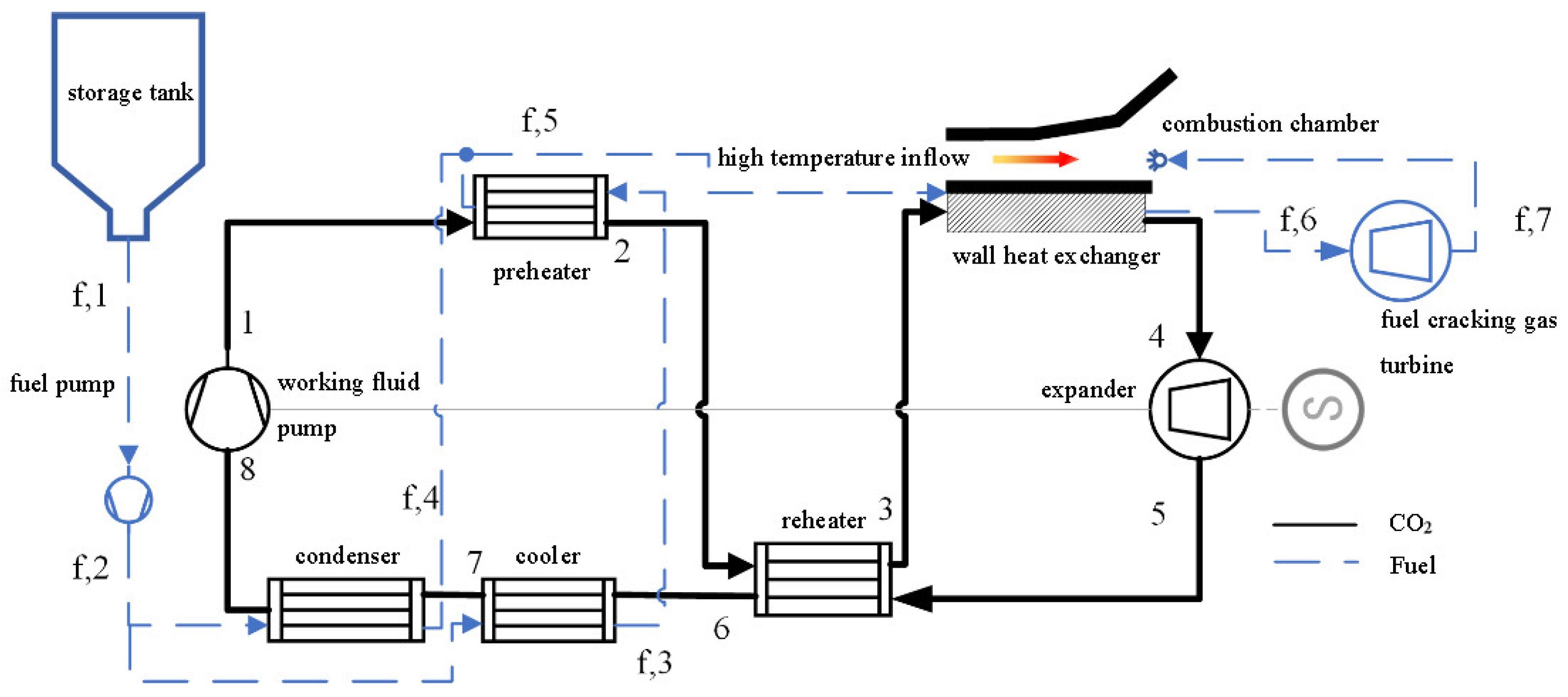
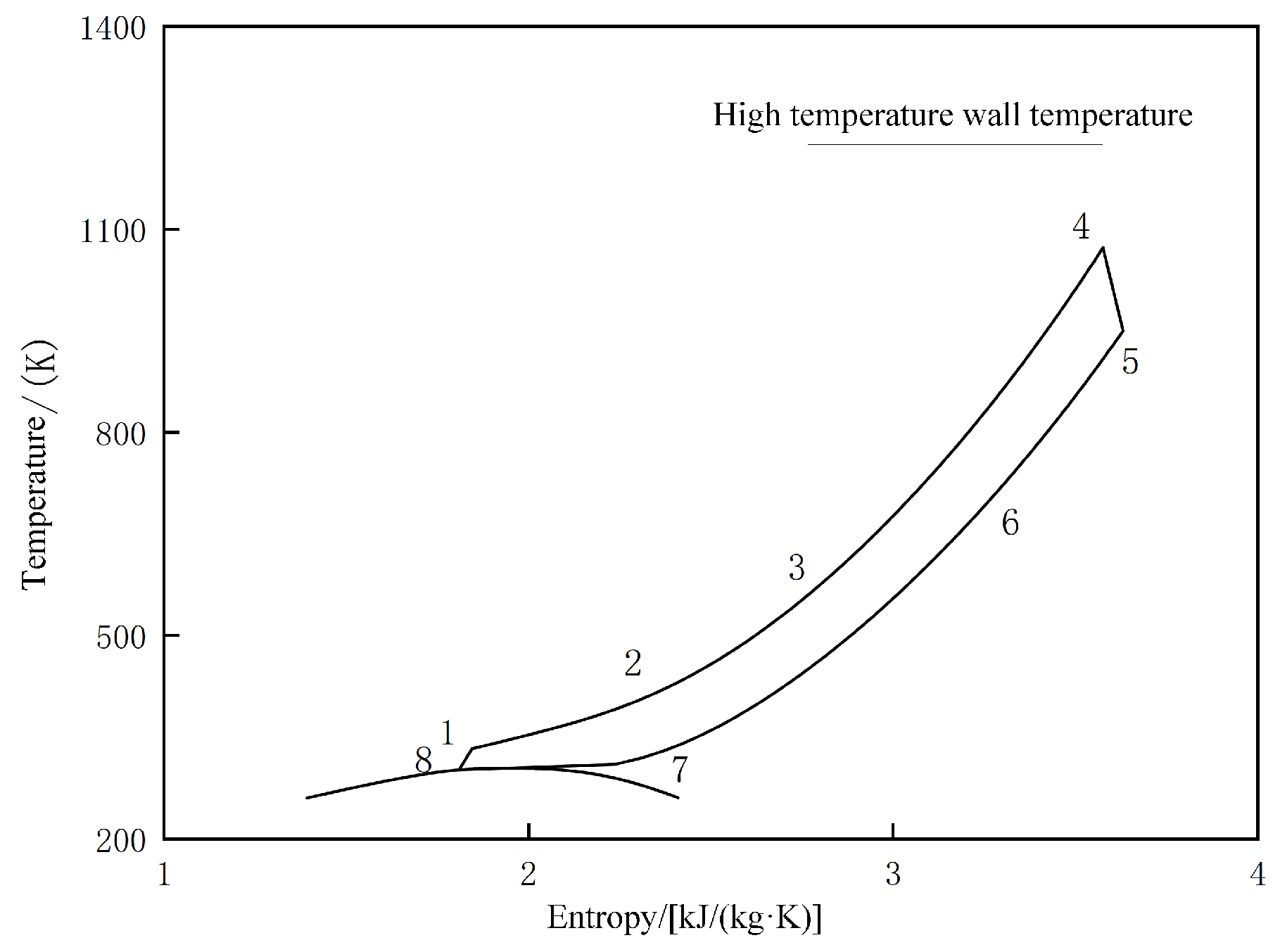
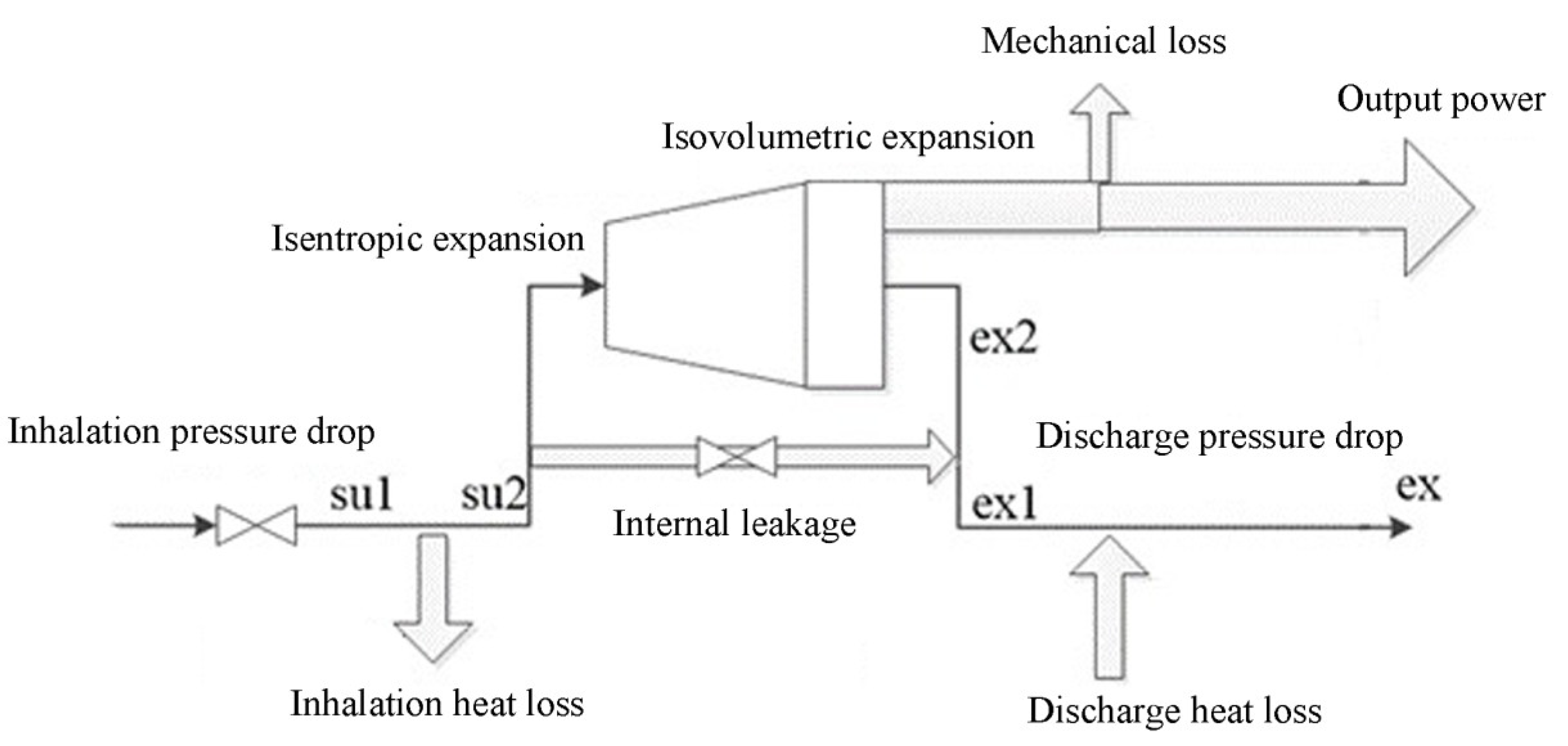

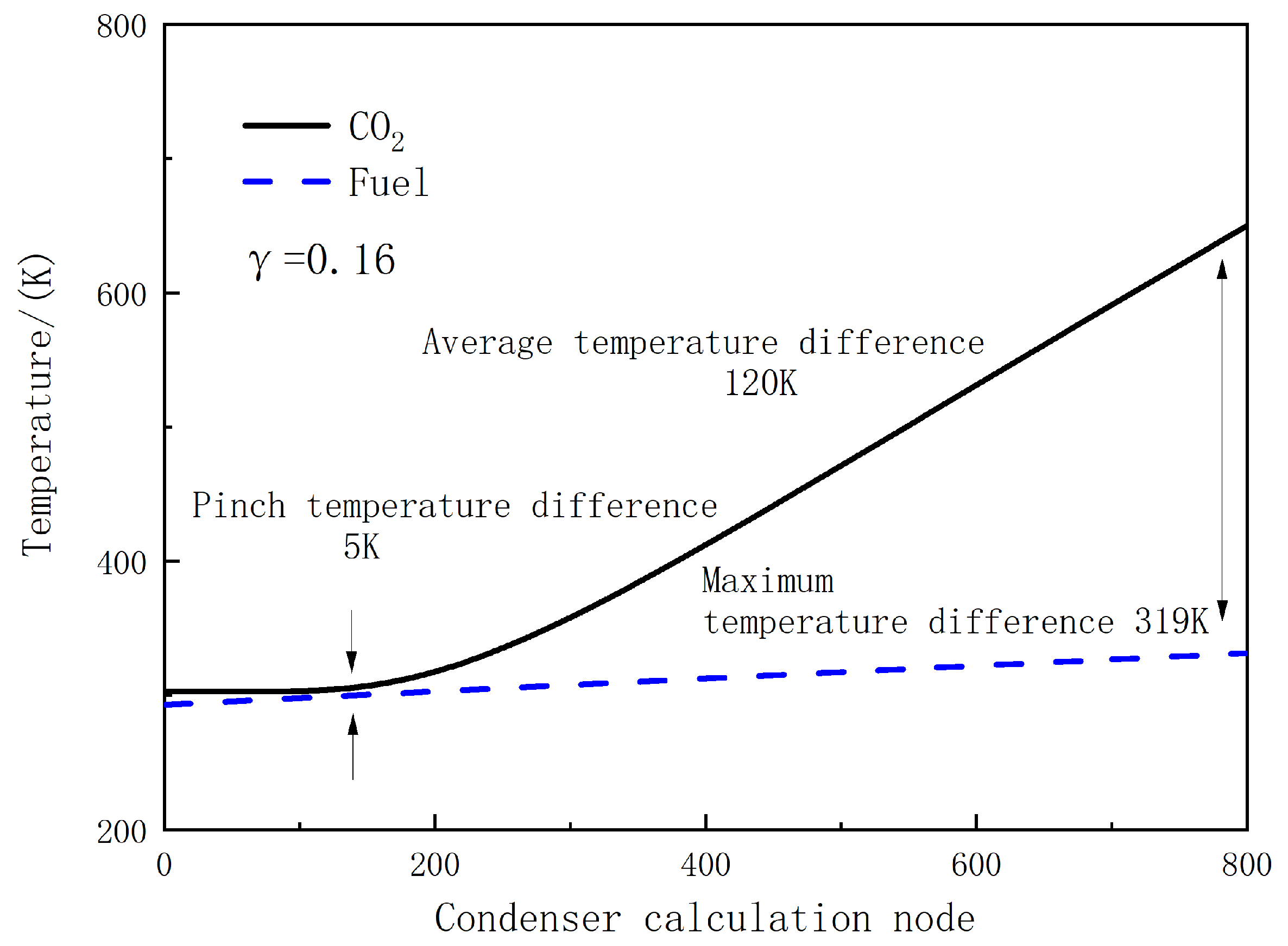

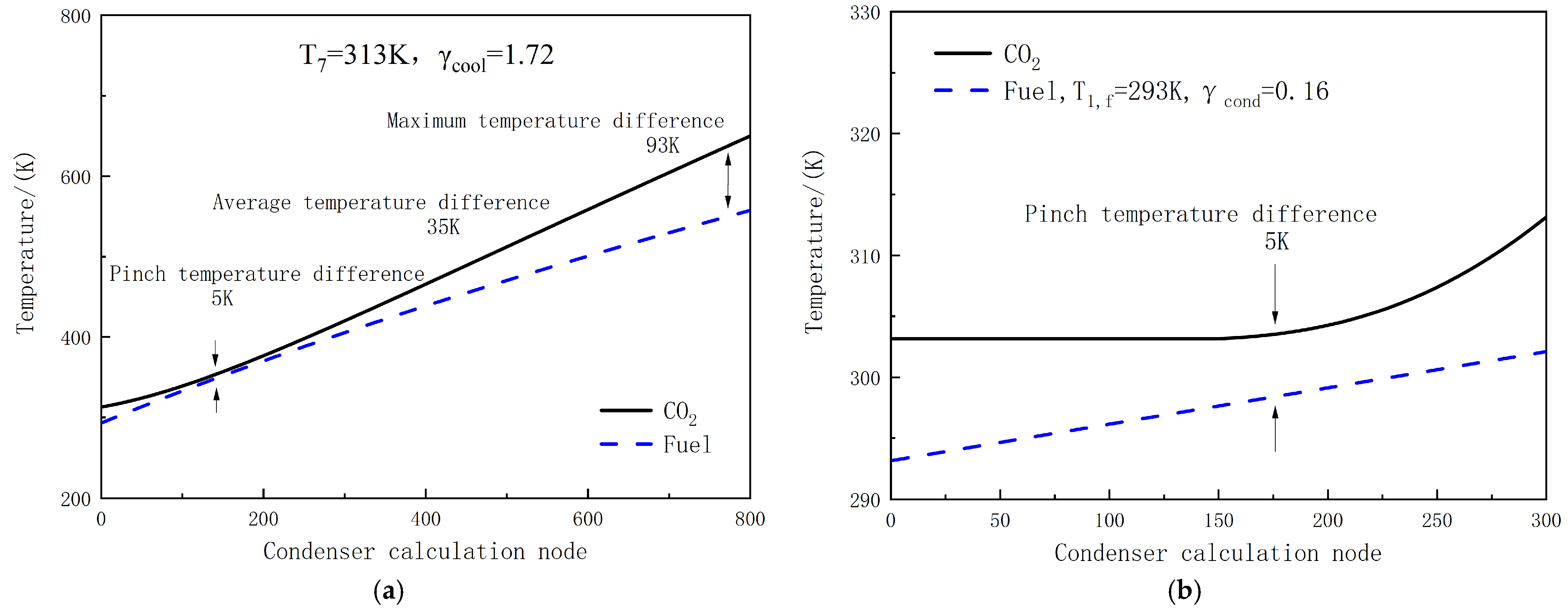
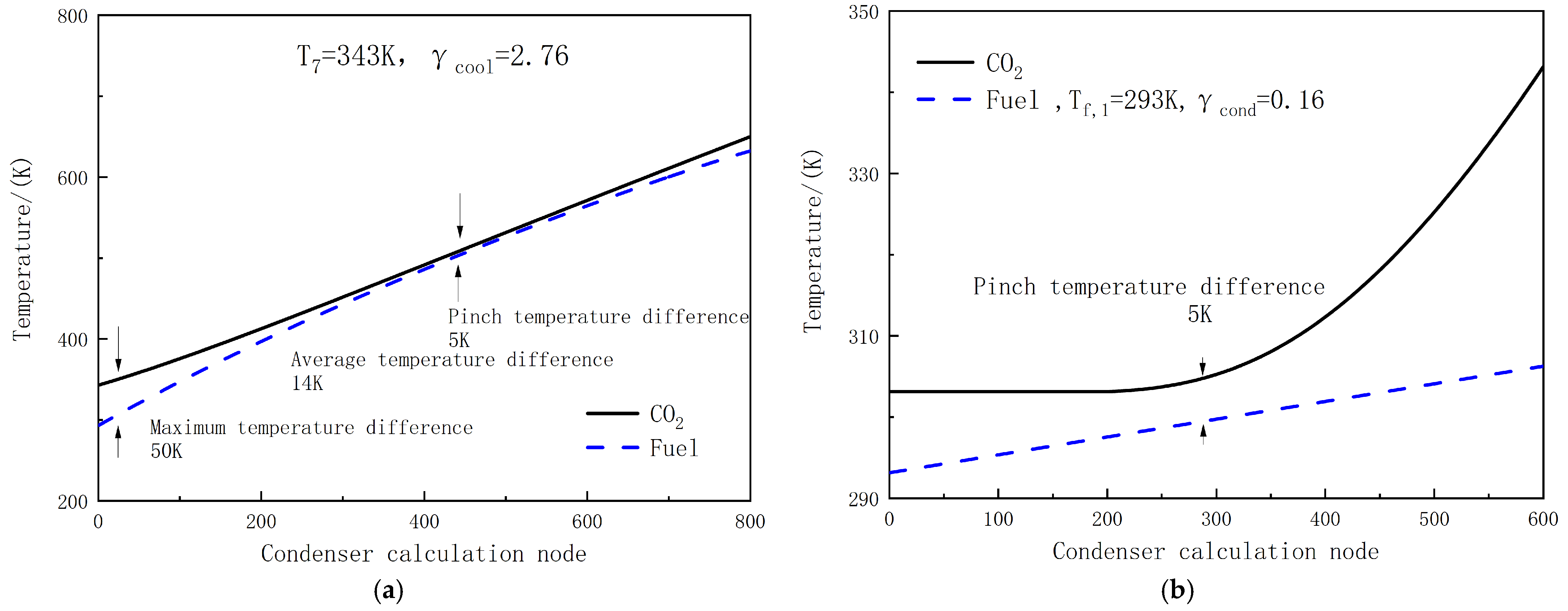
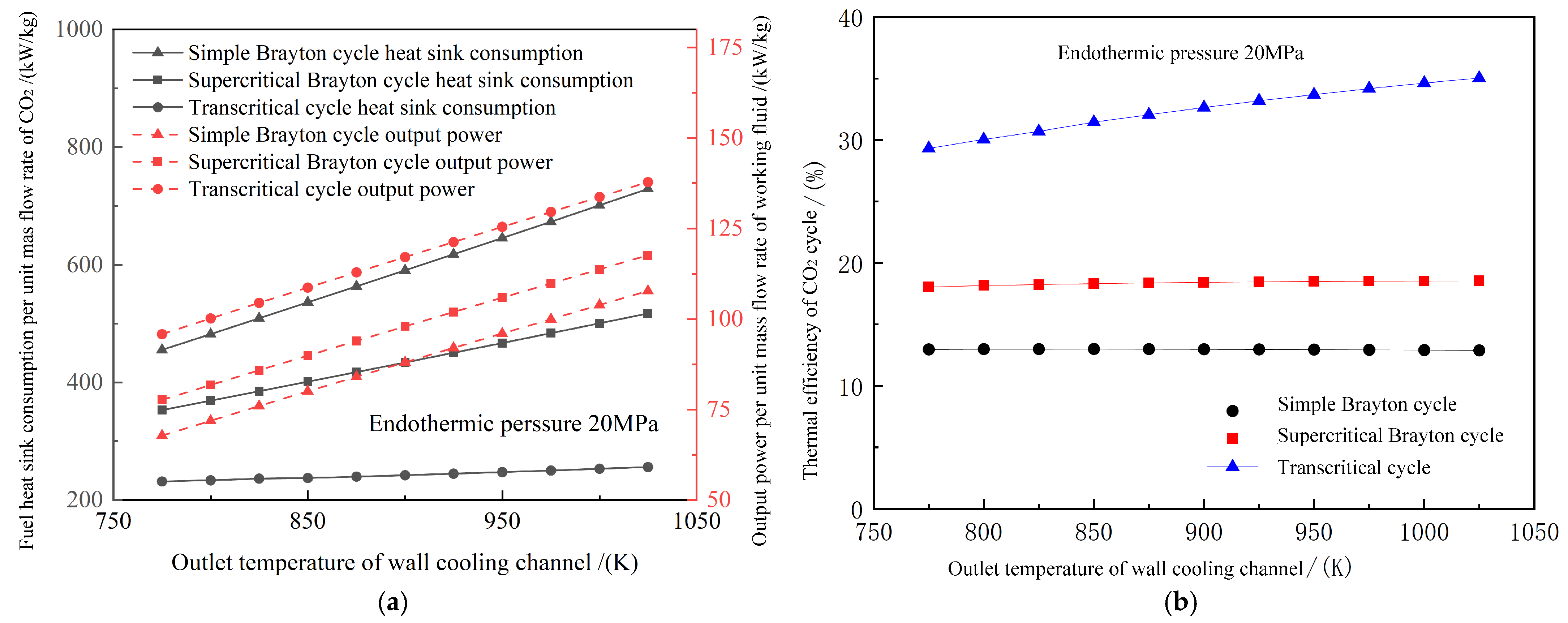
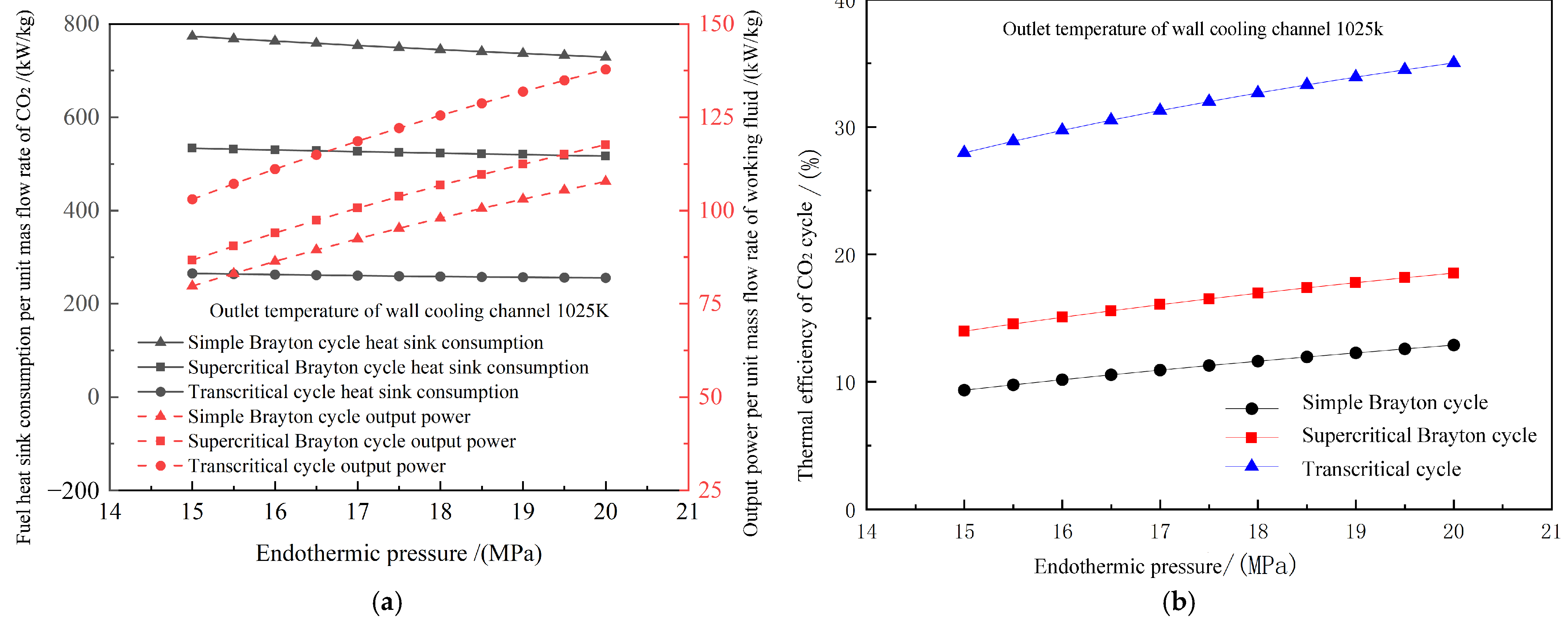
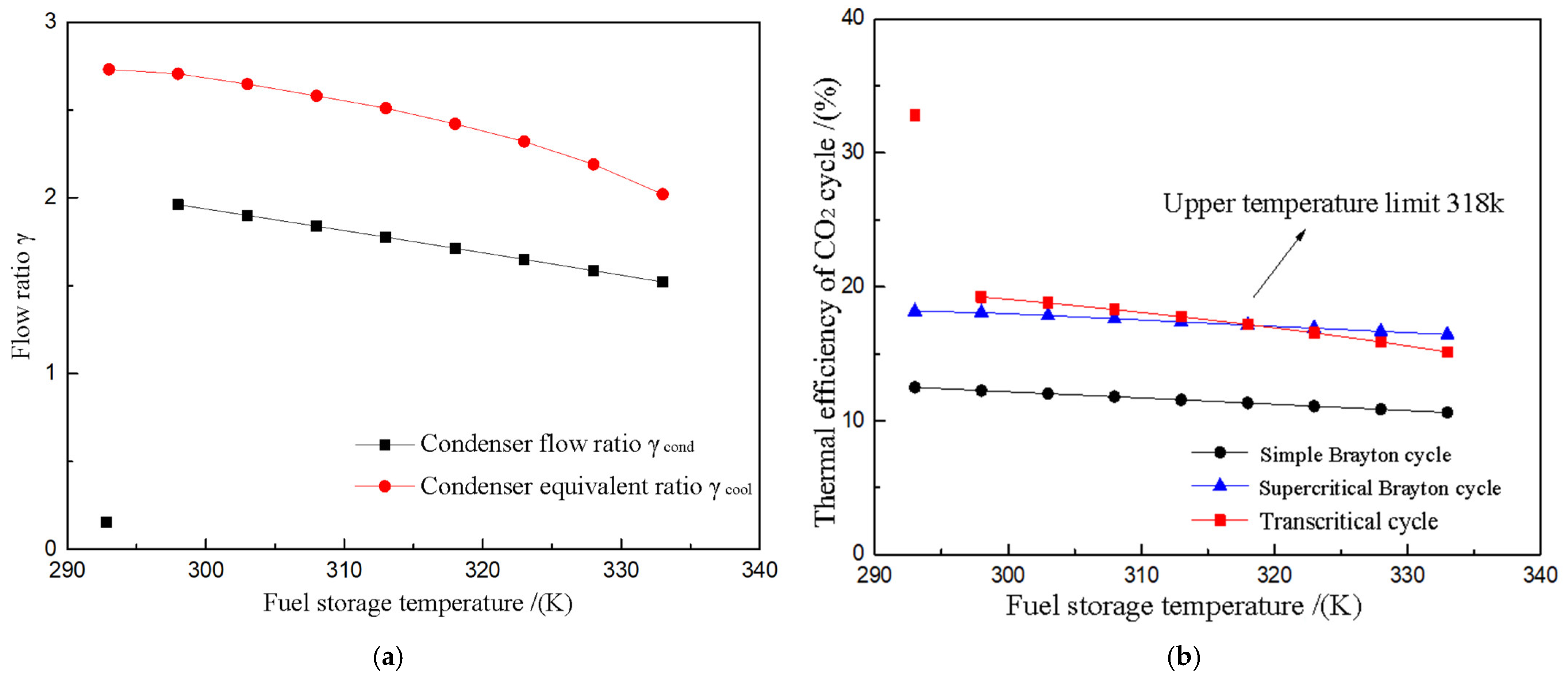


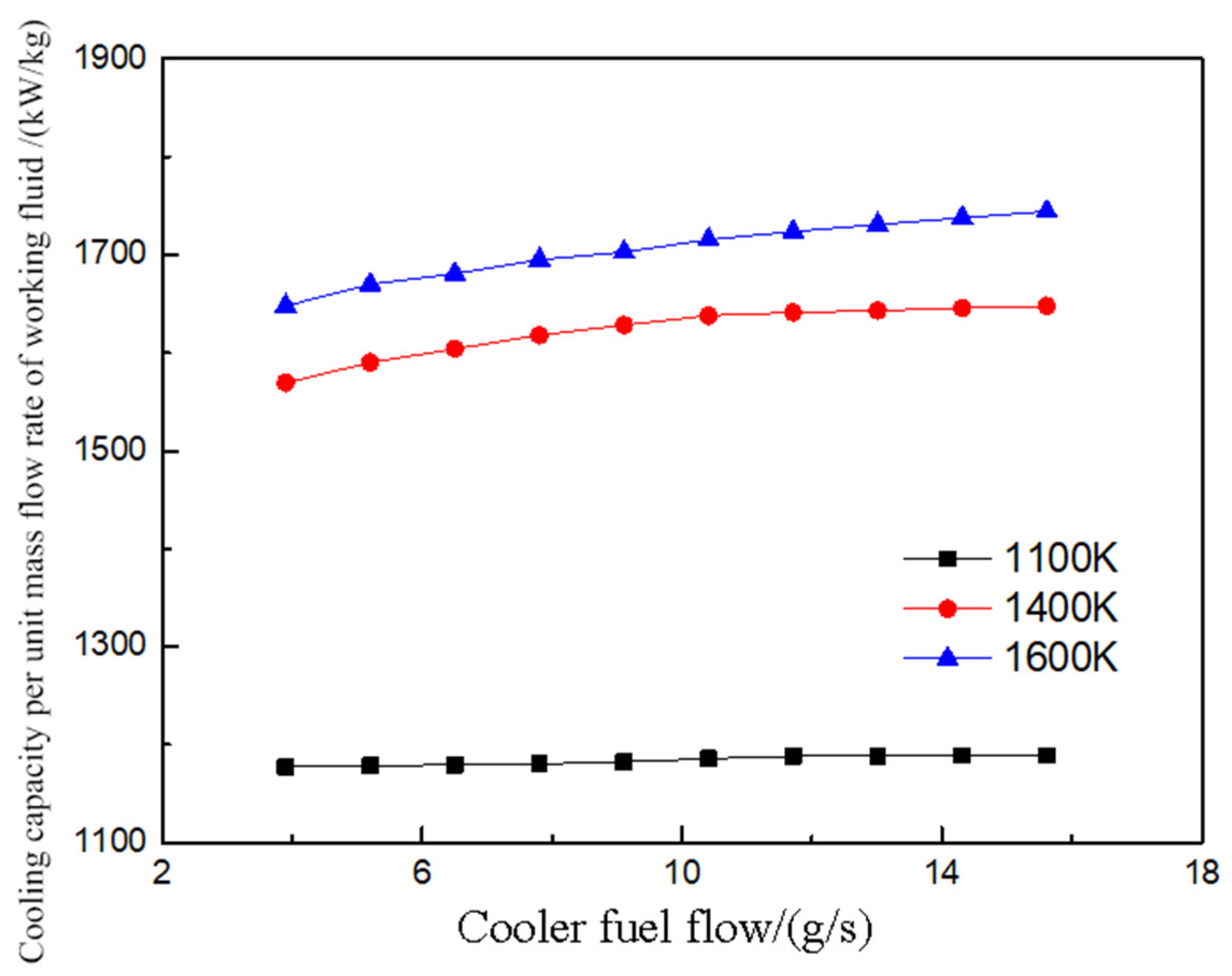


| Name | Numerical Value | Unit |
|---|---|---|
| Fuel storage temperature | 293 | K |
| Fuel storage pressure | 101 | kPa |
| Fuel operating pressure | 3 | MPa |
| CO2 condensation temperature | 303 | K |
| Condenser pinch temperature difference | 5 | K |
| Temperature difference at the cooler pinch point | 5 | K |
| Temperature difference at the pinch point of the preheater | 20 | K |
| Efficiency of the regenerator | 0.4 | |
| Isentropic efficiency of working medium pump | 0.9 | |
| Isentropic efficiency of fuel pump | 0.6 | |
| Isentropic efficiency of fuel turbine | 0.9 | |
| Expansion machine isentropic efficiency | 0.85 |
| Input Parameter | Hot Side | Cold Side | ||||
| Pressure (kPa) | Temperature (K) | Mass flow rate (kg/s) | Pressure (kPa) | Temperature (K) | Mass flow rate (kg/s) | |
| 2520 | 553.05 | 150.28 | 8353 | 381.05 | 327.81 | |
| Output Parameter | Hot Side Temperature Difference(K) | Cold Side Temperature Difference(K) | ||||
| Experimental value | Calculated value | Error (%) | Experimental value | Calculated value | Error (%) | |
| 161.5 | 169.4 | 4.90 | 141.1 | 147.8 | 4.70 | |
Disclaimer/Publisher’s Note: The statements, opinions and data contained in all publications are solely those of the individual author(s) and contributor(s) and not of MDPI and/or the editor(s). MDPI and/or the editor(s) disclaim responsibility for any injury to people or property resulting from any ideas, methods, instructions or products referred to in the content. |
© 2024 by the authors. Licensee MDPI, Basel, Switzerland. This article is an open access article distributed under the terms and conditions of the Creative Commons Attribution (CC BY) license (https://creativecommons.org/licenses/by/4.0/).
Share and Cite
He, Y.; Wang, L.; Dong, J.; Chen, Q. A Novel Fuel-Based CO2 Transcritical Cycle for Combined Cooling and Power Generation on Hypersonic Aircrafts. Energies 2024, 17, 4853. https://doi.org/10.3390/en17194853
He Y, Wang L, Dong J, Chen Q. A Novel Fuel-Based CO2 Transcritical Cycle for Combined Cooling and Power Generation on Hypersonic Aircrafts. Energies. 2024; 17(19):4853. https://doi.org/10.3390/en17194853
Chicago/Turabian StyleHe, Yijian, Lisong Wang, Jiaqi Dong, and Qifei Chen. 2024. "A Novel Fuel-Based CO2 Transcritical Cycle for Combined Cooling and Power Generation on Hypersonic Aircrafts" Energies 17, no. 19: 4853. https://doi.org/10.3390/en17194853




